Chapter 1: Urizen

Above is Plate 1, the title page of The First Book of Urizen, or in one copy simply The Book of Urizen. It exhibits Blake's protagonist Urizen in a definitive pose. He is writing with both hands, copying on sheets of paper from a book he is scanning with his feet. Urizen is not looking at the book; his eyes are closed, or open but lacking pupils. Perhaps he is blind. Like Blake, he sees with the mind. Behind him are two tombstone-like stone tablets. They suggest the tablets of the law, which in Blake's view are also the tablets of death. Above him the letters of the title curl like a serpent, and the tree behind him ends in whip-like branches.
What are we to make of this picture? In Blake's day, and for a century before his birth, England's artisan class was experiencing a resurgence of dissenting religious ideas, some of which resembled ancient Gnosticism. Closet to Blake's ideas was a group called the Ranters, then the Muggertonians, after one of its proponents Muggerton. Blake's parents may have been part of that movement. Blake himself briefly joined one group, associated with the 18th century mystic Swedenborg.
The main idea in common with the Gnostics was that the creator of the world was a lesser god, ignorant if not in some characterizations evil. Without knowing where his ideas were coming from, unable to see their source, he created by copying images unconsciously acquired from above, in the realm of the Eternals. Similarly, Urizen is copying with both hands from a book that he reads with his toes. The side of on his right seems to be letters, the other side seems to be pictures. Urizen is Blake's version of Jehovah, the god of Moses.
Urizen gives the gift of his Law to his creatures. There is "One King, one God, one Law," and he who disobeys will face his wrath. (Chapter II, section 8, line 7; this line is also Plate 4, line 40. Blake's method of etching, which he invented, combines words and pictures on one copper plate. Since some editions give his chapters and verses but not the plates they are on, I will include both.)
The beginning of the word "Urizen" in the title curls like a snake, while the end has hellish whips; Urizen the Law-giver for Blake is also Satan, ruler of this world. The poem implies as much when at the beginning of the poem he calls Urizen a "dark power" (I.1.7, or 1:7) and "shadow of horror" (I.1.1, or 1:1). In later works such as Jerusalem Blake tells us that Satan is "the Reasoning Power in Man" (Northrop Frye, Selected Poetry and Prose of William Blake, p. 302). Hence the name Urizen: "Your-reason."
The writing instruments in Urizen's two hands are different, at least in some versions of the picture.. A black and white photo of the copy in the Library of Congress (Eaves, p. 226) shows Urizen holding a quill pen in his right hand, and an engraving instrument in his left:
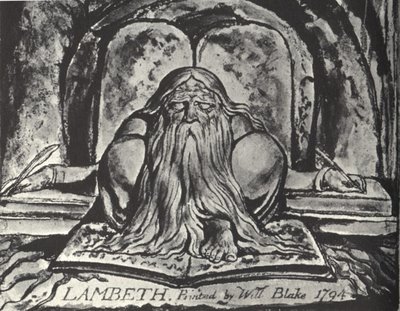
Like Blake himself, Urizen both writes and etches, from a pre-existing source. This says something about Blake's method. Blake's illustrations are not illustrations of his written text. Rather, both words and visual images are illustrations of something he sees and hears in his mind's eye and ear. Sometimes the reader will not find a specific passage in the narrative corresponding to a particular picture. He is not illustrating his text--he is illustrating what he perceives through his imagination..
Blake's caption to one print of this etching says, "Which is the Way The Right or the Left?" These two ways, I speculate, are the right-hand way of the Divine Word versus the left-hand way of the Image, or perhaps of Nature. Urizen's emphasis, as a caricature of the Biblical Jehovah and his Law, is on the Word. Blake, characteristically, simply holds the opposites.
Later in the text (Chapter VIII, or Plate 23) Urizen bears four sons, emanations that correspond to the ancient belief that the world is composed of four elements, earth water, air, and fire. Blake's etching has the four together, in their associated element (Plate 24).
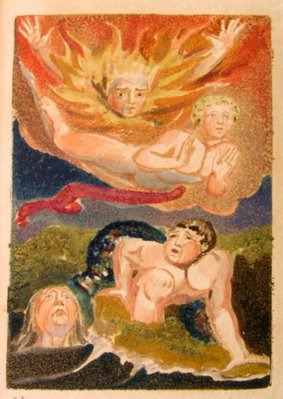
I bring in this picture now, as opposed to when it occurs in the text, because the four sons are also four aspects of Urizen himself, as he moves through the poem. Moreover, the four elements connect the poem to Renaissance alchemy, which also utilized the four elements. For the alchemists the four elements were four constituents of human nature and four types of human existence.
I have found no record of Blake's having actually consulted alchemical works. However his biographers say he was always looking at old books for ideas. And he certainly looked at Renaissance emblem books, of which the alchemical books were an offshoot. He even did an emblem book himself, The Gates of Paradise, published in 1793. Under four of its first engravings are the names of the four elements.
Let us start with the element of earth. Blake has an etching of Urizen surrounded by it. This stone-faced, immovable figure, squinting out onto the world, could be either Urizen or his son Grodna, corresponding to the element of earth (Plate 9):
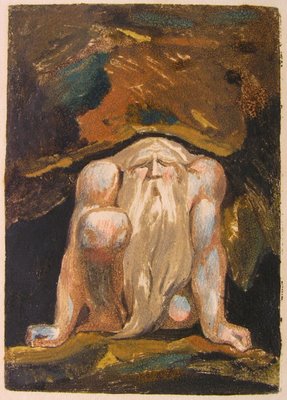
Blake says that at his birth Grodna "rent the deep earth, howling/ Amaz'd" (VIII.3.8-9, or 23:15-16). At the same time this figure resembles Urizen himself. It corresponds to Urizen's own state as he writes the Law; it was "written in my solitude" (II.7.3, or 4:33) while "hidden, set apart, in my stern counsels" (II.4.3, or 4:8). Those whom he would control by mean of his Law, personifications of the seven deadly sins and the seven planets, then chase him until he hides in the earth: "...a roof vast, petrific around/ On all sides he fram'd, like a womb" (III.7.1-2, or 5:28); there "Urizen laid in a stony sleep" (III.10.1-2, or 6:7).
In alchemy what corresponds is the metals underground, as infants with the earth as their nurse. The Atalanta Fugiens of 1618 shows them as cubs sucking on a she-wolf in a cave.

As in the story of Romulus and Remus, the founders of Rome, a human child is there as well. He bears the sign of Mercury, the catalyst who purifies himself and all the rest.. What corresponds to this condition in Jungian therapy is the so-called "normal" state of humanity, oriented around goals within one's society milieu, conditioned by one's family environment and early experiences.
Blake also gives us an Urizen-like figure in Water (Plate 12):
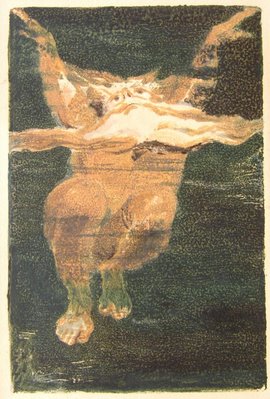
The figure seems barely conscious. The son is Utha, who "from the waters emerging, laments" (VIII.3.7, or 23:14). Blake's figure seems to drift more than swim. For Urizen, what corresponds is his "hiding in surgeing Sulphureous fluid his phantasies" (Urizen IVb.2.3-4, or 10:13-14) after Los, another eternal, confines him with his nets of iron. Urizen's mind
...began to rollFor this stage of water alchemy usually has two figures, male and female, entwined in each other, later to become the hermaphrodite. However here is one that shows a male alone, from the 1618 Atalanta Fugiens: .
Eddies of wrath ceaseless round & round,
And the sulphureous foam, surgeing thick,
Settled, a lake, bright & shining clear...(IVb.3.1-5, or 10:19-24)
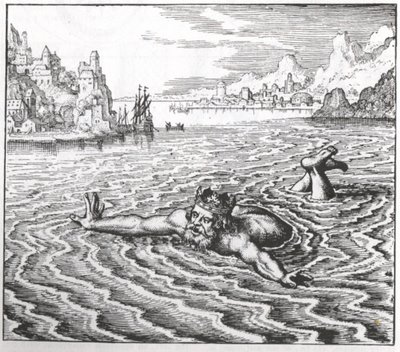
The psychological state here is one of helplessness and terror, longing for a firm foundation. It at this point that people often make the decision to enter therapy.
Another figure in Blake corresponds to Air (Plate 14):

Erdmann sees this figure floating in the sky, bouncing against either clouds or rocks. It could be Urizen's son Thuriel, who appears "Astonished at his own existence,/ Like a man from a cloud born" (VIII.3.5-6, or 23:12-13).
In Urizen's story, the airy state corresponds to his condition at the beginning, when he is still in the void but "searching for a solid without fluctuation" (II.4.6, or 4:11). Urizen also seems to take the Thuriel persona at the end of the poem, after his sons and daughters populate the earth and fail to follow his commandments. Blake says, "Cold he wandered on high, over their cities/ In weeping & pain & woe" (VIII. 6.1-2, or 25:5-6). But Urizen never has the playfulness that seems evident in Blake's figure of Plate 14.
The pose in Blake's image is similar to that of the "Hanged Man" in tarot, signifying reversal, things turning upside down. For Urizen, things have turned upside down, out of his control. The alchemists associated this "Hanged Man" pose with the element of air, specifically to vaporization out of water (Wellcome Institute Library, London (ms. 29, Fol. 40)):

Again, the dominant emotion is that of reversal--what was formerly heavy is now light, requiring a container to keep it from dissipating and poisoning whatever it touches. In Jungian therapy, the corresponding stage is the fantasies that the patient brings to the analyst, in dream-narratives or art-works, as well as untypical behavior that may cause alarm to himself or others. Typically these are strikingly at variance to one's previous existence.
Last born of Urizen's sons is fire, springing from the loins of Urizen. This bearded figure is of Urizen's son Fuzon, who, Blake says, "flamed out, first begotten, last born" (VIII.3.9, or 23:18; Plate 16):
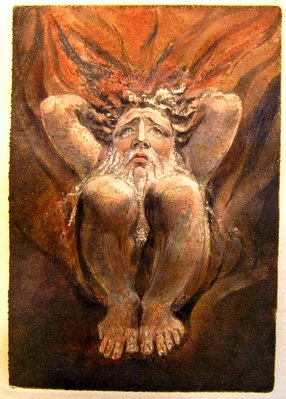
Again, the figure could also be Urizen himself early on, emerging from the chaos.
An etching further on shows Urizen in fire shows him in shackles (Plate 22):

These shackles were formed by Los, the divine blacksmitht whom we will meet later on. Here Urizen's torment turns him red-hot. The caption reads, "Frozen doors to mock The World/ while they within torments uplock." In the poem Blake describes Urizen's agony:
Restless turn'd the Immortal inchain'd,In the picture, the red, fiery glow emanating from Urizen's head expresses the torment of an enchained will. Erdmann observes that the chains are forged by his own mind to mock the world; they lock him into his own torments. Similarly, the patient's superego, or perhaps its representatives in the outer world, chastise him for his horrible fantasies. Failing that, the analyst gently advises that the patient hold off from any major life-decisions and let the passion do its transforming power in a safe container of art, dreams, and analysis.
With hurtlings & clashings groans
The Immortal endur'd his chains,
Tho' bound in a deadly sleep. (V.1.6-8, or 13:25-27)
Here, from the 1622 Philosophia Reformata, are earth and fire together, like Urizen in shackles:
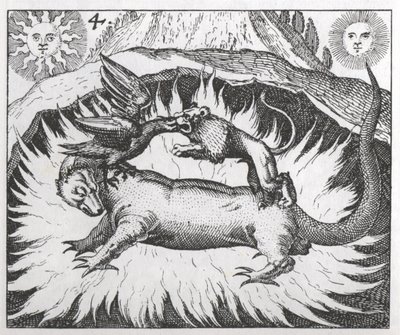
The eagle and the lion, lords of air and earth, fight it out on the back of the salamander, the image for the alchemists of that which persists through the heat of the fire.The first letters of its name are the same as those of the word "sal," Latin for salt.
Finally, let me present an alchemical illustration with all four elements, a watercolor from the 16th century. This one picture contains within it the outline of an entire creative lifetime, one that can serve to structure our look at Blake's life. To make it easier to read, I have divided the picture in half, the top half as the top image here and the bottom half the bottom image:


I see this design as a progression from the bottom up and then the top down. At the bottom are two fire signs, Leo and Ares, next to the alchemist and his wife, also known as the soror. This is the pre-alchemical state of human existence. It corresponds to Blake and the feminine figures in his life, real and imaginal, and most notably his wife Catherine, Notice also the sun and the moon, images that we will see in Blake as well. Between these two, perhaps even from their interpersonal conflicts, they generate the heat that dissolves the alchemist's body--actually, the prima materia, or prime matter, of the work, separating it into its earth and its water. This is the state of floating, helplessly except where there is union with the contra-sexual figure, in which case the state approximates divine bliss, With continued fire, the liquid becomes a gas, where as spirit it connects with its twin angel. This is the state in which an artist such as Blake gets his inspiration, as though from another world, although one may also deny such influx, as Urizen does. Another fire sign, the archer, keeps the purified substance, now a king, between worlds and looking disdainfully down at mere mortals below. But the archer shoots an arrow into the king's heart. a mortal wound that bursts his bubble, so to speak. Now the movement reverses. In decline his spirit is even more closely connected to the other world, aided by his twin, or simply sinks into stagnation, while his body slowly decomposes. This slow work releases the life-substance in a form that gives the ego and those who come after a new taste of immortality by means of the elixeers that pour out of him. In what follows we shall see how Blake's life and that of his alter ego Urizen follow this structure in the course of Blake's life and work.

0 Comments:
Post a Comment
<< Home